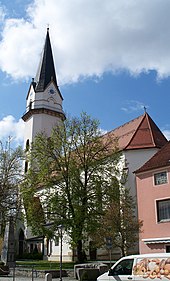Assumption of Mary (Hofkirchen)
The Roman Catholic parish church of the Assumption of Mary is a late Gothic hall church in Hofkirchen in the Lower Bavarian district of Passau . It belongs to the parish association Hofkirchen in the dean's office Vilshofen of the diocese of Passau .
History and architecture
The church was built at the beginning of the 16th century; the core of the lower floors of the tower is older, the upper part dates from the late 19th century. In 1962 the nave was extended on both sides by low side aisles, with the northern and southern signs being included.
The building was erected in plastered brickwork. The nave and the slightly retracted choir are under one roof. The building is structured with three-part buttresses . The windows are adorned with rich tracery of baked clay formed from interpenetrating arches and fits. The lavishly designed inner portals of the portals are made of limestone with two deep throats as well as round and pear rods that penetrate into the apex of the arch. A tympanum field is arranged above the lintel .
Assumption of the Virgin Mary is one of the larger country churches in the region and belongs to the latest Gothic style , which has been developed here to fantastic exaggeration of the usual structures, especially the vaulted ribs. The four-bay nave is adjoined by a slightly raised choir with three bays and three-eighths connection , which is enhanced in its intrinsic spatial effect by a considerably recessed choir arch . On all walls there are grooved shield arches , which are more powerful in the nave with semicircular services, in the choir weaker with polygonal services. The net ribs are double filleted and formed with penetrations. Large quadrupeds are arranged in the apex of the choir vault . Tense net figures are designed in the ship. The path in the top of the vault is emphasized by strongly longitudinally directed diamonds made of double parallel ribs, while the laterally rising diamonds are provided with winding approaches. The fanned capitals to accommodate the ribs are unusually large, the profile bars are treated like branches. The gallery in the west is vaulted with three bays with a close-meshed diamond net with ribs stuck through. The profiled arches are made of granite, the other ornamental shapes are made of limestone. Two empty canopies for sculptures are attached to the front wall. The partially renewed parapet is designed with a pattern of circular passes, which are connected by additional partial passes and curved foothills.
Furnishing
The altars are neo-Gothic works . The high altar was bought on the occasion of the renovation in 1988/1989, the side altars were created in 1855 by Franz Seywald from Hengersberg. The stained glass in the choir apex window dates from the early 16th century and shows a crescent moon Madonna in a halo. In chorus two are Epitaphien the Renaissance for Wolf Jakob white fields Hilgartsberg († 1590) and White Ottheinrich fields († 1592) obtained which are worked in limestone with red marble and formed in the same orders. The finely worked reliefs show the resurrection and Christ in limbo, below each the kneeling figures of a knight with his wife. A small altar was created in the middle of the 18th century. The carved figures of a crucifixion can be found in the nave, with assistance figures from the first half of the 16th century and a late baroque crucifix.
The ringing is formed by five bells, the oldest is from 1864, three are from 1953 and the youngest is from 2011.
literature
- Georg Dehio : Handbook of the German art monuments. Bavaria II - Lower Bavaria. Deutscher Kunstverlag, Munich, Berlin 2008, ISBN 978-3-422-03122-7 , pp. 219-220.
Web links
- Information on the Hofkirchen Church on the website of the Diocese of Passau
Individual evidence
- ↑ Information about the bell on the website of the Diocese of Passau. Retrieved January 6, 2020 .
Coordinates: 48 ° 40 ′ 41.2 ″ N , 13 ° 7 ′ 3.1 ″ E

